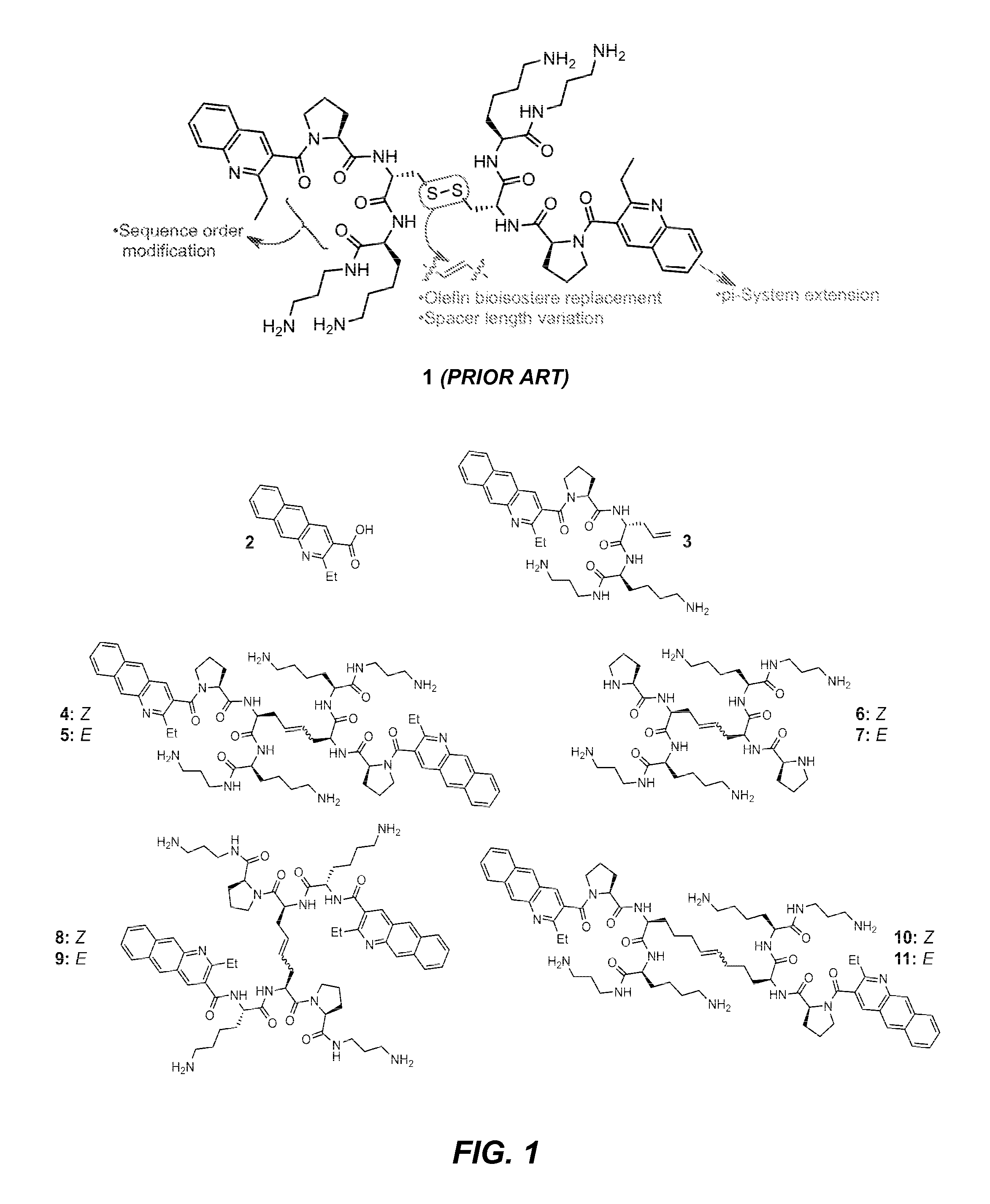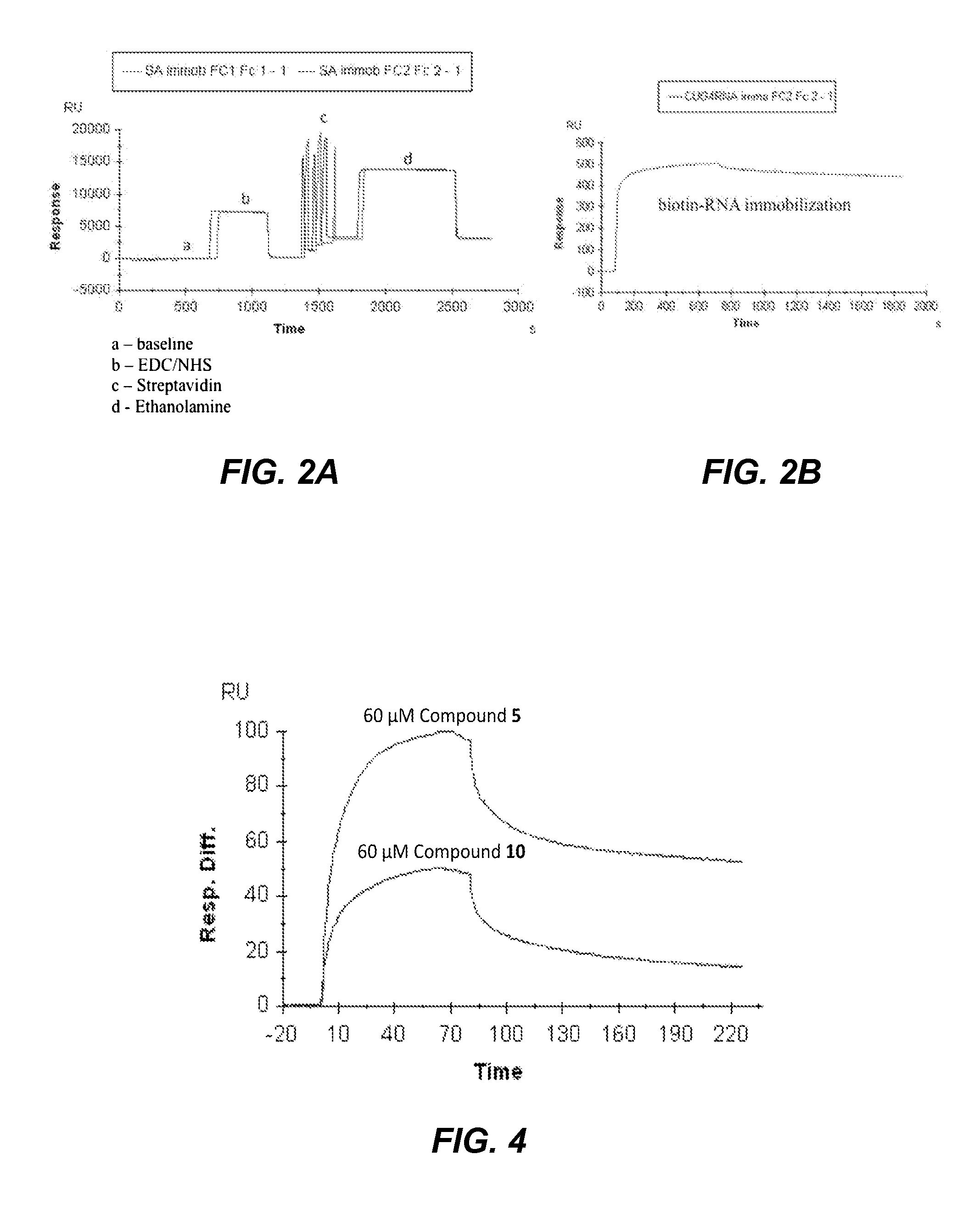Nucleic acid binding compounds, methods of making, and use thereof
a technology of nucleic acid and compound, applied in the field of nucleic acid binding compounds, can solve the problems of under-examined challenge in chemical biology, misregulated alternative splicing, spliceopathy, etc., and achieve the effect of improving the binding affinity and selectivity of the target rna molecules, effective treatment of diseases, and inhibiting the activity of the target nucleic acid molecules
- Summary
- Abstract
- Description
- Claims
- Application Information
AI Technical Summary
Benefits of technology
Problems solved by technology
Method used
Image
Examples
example 1
Synthesis of 2-Ethyl Benzo[g]quinoline Carboxylic Acid (Compound 2) from Commercially Available Acrolein
[0183]Scheme 1, shown in FIG. 29, was used to synthesize intermediate compound (2), 2-ethyl benzo[g]quinoline carboxylic acid.
[0184]Ethyl-3-nitropropanoate (Scheme 1, d) was prepared by following literature procedure (Silva et al., “An Expeditious Synthesis of 3-Nitropropionic Acid and its Ethyl and Methyl Esters,”Synthetic Communications 31:595-600 (2001), which is hereby incorporated by reference in its entirety) starting from commercially available acrolein (Scheme 1, a). Spectral data were comparable to that reported in the literature. Ethyl-3-nitropropanoate (Scheme 1, d): 1H NMR (400 MHz, CDCl3) δ: 4.62-4.39 (m, 2H), 4.03 (q, J=7.1 Hz, 2H), 2.92-2.69 (m, 2H), 1.12 (t, J=7.1 Hz, 3H). 13C NMR (126 MHz, CDCl3) δ: 169.64, 69.72, 61.22, 30.84, and 13.82.
[0185]3-Nitro-2-naphthoic acid (Scheme 1, f) was synthesized by reacting O-phthaldialdehyde (Scheme 1, e) with ethyl-3-nitroprop...
example 2
Synthesis of Monomer (3) and Dimers (4)-(11)
[0189]Compounds 3-9 (FIG. 1) were synthesized on solid phase by analogy to methods previously reported (PCT Publ. No. WO 2009 / 015384; Palde et al., “Strategies for Recognition of Stem-loop RNA Structures by Synthetic Ligands: Application to the HIV-1 Frameshift Stimulatory Sequence,”J. Med. Chem. 53:6018-6027 (2010), which is hereby incorporated by reference in its entirety). For compounds 10 and 11 (FIG. 1), L-pentenyl glycine was synthesized via asymmetric alkylation of pseudoephedrine glycinamide (Myers et al., “Highly Practical Methodology for the Synthesis of d- and l-α-Amino Acids, N-Protected α-Amino Acids, and N-Methyl-α-amino Acids,”J. Am. Chem. Soc. 119:656-673 (1997), which is hereby incorporated by reference in its entirety).
[0190]For compounds 3, 4 and 5, replacement of the disulfide in lead compound 1 with a non-labile olefin (C═C) bioisotere was performed according to procedures similar to those described in a recent report ...
example 3
Analysis of Dimer Binding Affinity via Surface Plasmon Resonance
[0201]SPR binding measurements were performed on a Biacore-X instrument (Biacore, Inc., Uppsala, Sweden) with two flow channels (FC1 and FC2). 5′-Biotinylated-RNA sequences, with a C6 linker separating the biotin label from the RNA (Integrated DNA Technologies Inc.) were immobilized on streptavidin (Rockland Immunochemicals) functionalized carboxylmethyl dextran coated sensor chips (CM5, G.E. Healthcare) using EDC / NHS (Advanced ChemTech) coupling chemistry. Filtered (0.2μ), degassed and autoclaved HBS-N buffer (0.01M Hepes, pH=7.4, 0.15 M NaCl) was employed as sample and as running buffer for all SPR experiments. A typical protocol for an experiment is as follows: A CM5 sensor chip was allowed to equilibrate to room temperature and then docked into the instrument. Following priming with running buffer, FC1 and FC2 were conditioned by manual injection of 20 μL aqueous NaOH (50 mM) at a flow rate of 30 μL / min. This was re...
PUM
| Property | Measurement | Unit |
|---|---|---|
| pH | aaaaa | aaaaa |
| diameter | aaaaa | aaaaa |
| particle size | aaaaa | aaaaa |
Abstract
Description
Claims
Application Information
 Login to View More
Login to View More - R&D
- Intellectual Property
- Life Sciences
- Materials
- Tech Scout
- Unparalleled Data Quality
- Higher Quality Content
- 60% Fewer Hallucinations
Browse by: Latest US Patents, China's latest patents, Technical Efficacy Thesaurus, Application Domain, Technology Topic, Popular Technical Reports.
© 2025 PatSnap. All rights reserved.Legal|Privacy policy|Modern Slavery Act Transparency Statement|Sitemap|About US| Contact US: help@patsnap.com



